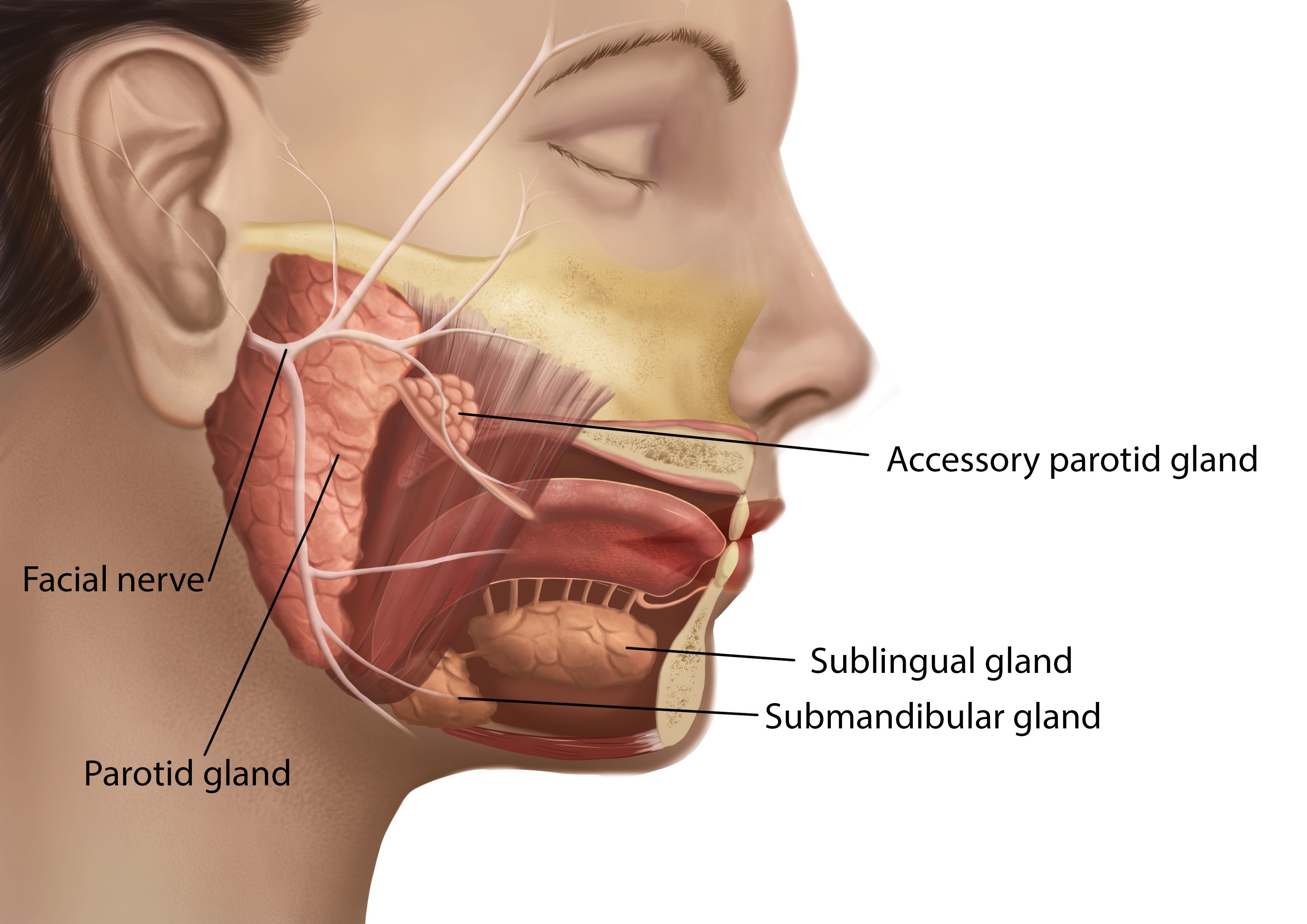Parotid Gland Anatomy

Parotid Gland
There are three major salivary glands in the body. The parotid gland is the largest of the major salivary glands and is located in front of the ears on each side of the face. The parotid gland produces saliva and helps with chewing and digesting food. It can vary in size and shape.
The facial nerve runs through the parotid gland, and it artificially separates the gland into two parts: the superficial lobe and deep lobe. The superficial lobe is located above the facial nerve. The deep lobe is located beneath the facial nerve.
The facial nerve is comprised of many branches that control the movement to the face. The two main branches of the facial nerve are the upper division and lower division. The upper division controls movement to the forehead, eyelids, and upper lip. The lower division controls movement to the lower lip, chin, and superficial neck muscles.
Accessory Parotid Gland
The accessory parotid gland contains normal salivary tissue that did not get included inside the parotid gland capsule during prenatal development.
It is located at the front edge of the parotid gland above the parotid duct. It drains into the parotid duct.
It is possible for tumors to develop in the accessory parotid tissue. A tumor in this area may appear as a mass in the mid-cheek area.
Only certain people have accessory parotid gland tissue, so not all patients will have this as part of their anatomy.
Parotid Lymph Nodes
There are lymph nodes inside and outside the parotid gland. Lymph nodes drain certain “territories” in the body. The parotid lymph nodes are primarily the lymphatic drainage system for the facial skin, eyelids, scalp, and ear.
The lymph nodes contained in the parotid gland, which are also called intra-parotid lymph nodes, are located throughout the gland. The most common cancer to metastasize to parotid lymph nodes is skin cancer.
The number of intra-parotid lymph nodes is generally equal to the amount of the gland. For example, the superficial lobe makes up 80% of the parotid gland and approximately 80% of intra-parotid lymph nodes are located in the superficial lobe.
The deep lobe makes up 20% of the parotid gland and approximately 20% of intra-parotid lymph nodes are located in the deep lobe portion of the gland.
Other Salivary Glands
The submandibular gland is the second largest major salivary gland and is located under the jaw. It produces thicker mucus saliva. There are no lymph nodes in the submandibular gland.
The smallest of the major salivary glands is called the sublingual gland, which is located on the floor of the mouth underneath the tongue. It is responsible for producing thick saliva. There are no lymph nodes in the sublingual gland.
There are also many minor salivary glands that are located on the roof of your mouth, lips, tongue, cheek, nose, and throat that are responsible for the steady production of saliva.
While it is possible to have tumors located in any area of the salivary glands, the majority of salivary gland tumors are located in the parotid gland.
References
1. Olsen, KD (1987). The Parotid Lump-Don't Biopsy It! In KD Olsen, Salivary Gland Disease and Treatment (pp. 5-11). Rochester, MN: Mayo Clinic Department of Otolaryngology, Head and Neck Surgery.
2. Beahrs, OH and Adson, MA (1958). The Surgical Anatomy and Technic of Parotidectomy. In KD Olsen, Salivary Gland Disease and Treatment (pp. 12-23). Rochester, MN: Mayo Clinic Department of Otolaryngology, Head and Neck Surgery.
3. Olsen, KD (2000). Carcinoma of the Major Salivary Glands. In KD Olsen, Salivary Gland Disease and Treatment (pp. 174-184). Rochester, MN: Mayo Clinic Department of Otolaryngology, Head and Neck Surgery.
4. The content in this section was drafted in consultation with Eric J. Moore, M.D., and Kerry D. Olsen, M.D., of the Mayo Clinic in Rochester, MN.



